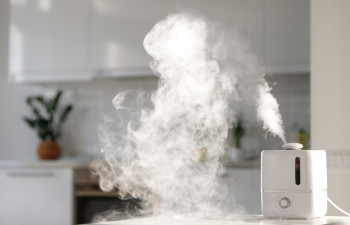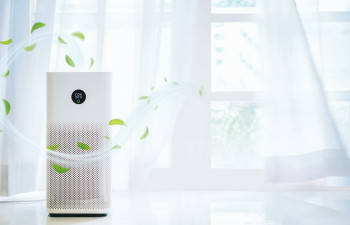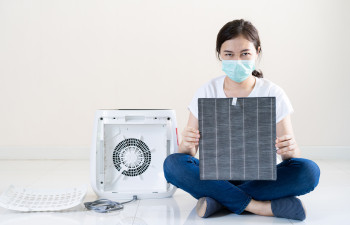Do air purifiers help with smoke?
Every day, we breathe in air pollutants but we’re not always aware of them. Airborne particles hang in the air, settle on surfaces and embed themselves into our soft furnishings and carpets.
A major cause of dirty air and reduced indoor air quality is smoke. The most common smoke in the home that comes to mind is tobacco smoke, but second-hand smoke comes from other sources in the home too.
What are smoke sources?
Tobacco smoke, of course, can have a big impact on indoor air quality. At home, smoke can also come from a number of different sources. Let’s look at some of these sources and what they release into the air around you.
- Wood smoke – If you have a wood-burning stove or a fireplace, you will be burning logs, especially in the colder months. Wood releases several chemical pollutants, including acrolein, formaldehyde, benzene and carbon monoxide, an odourless, colourless gas released from wood that has not completely burnt through. Long-term exposure to these pollutants can seriously affect your health. The Environment Protection Agency in the UK says that certain illnesses, such as severe asthma attacks and acute bronchitis, as well as reduced lung function, can all be linked with too much exposure to burning wood.
- Burning candles – If you love burning candles and incense at home, the smoke produced can irritate your nostrils, throat and even your lungs. This can cause coughing and also trigger asthma attacks. However, burning candles not made from paraffin wax, a petroleum by-product, can significantly reduce smoke levels.
- Cooking – You might not think that cooking the evening meal can affect the air quality around you. But it does, particularly if you have a wood-burning stove or an AGA range. Vapour from boiling water can also impact your health if you suffer from allergies. Get an extraction fan fitted in your kitchen above your stove or cooking area and keep windows open where possible.
- Heating – Electric heating isn’t a problem but if you heat your home using gas, oil or wood, smoke can be produced. Tiny particles of nitrogen dioxide can be released into the air, and if you heat your home using coal, or use this on an open fire, the levels of pollutants are much higher.
- Tobacco smoke – Whether you’re a smoker or you share a home with someone who is, this is one of the most harmful types of smoke. It is a major cause of poor indoor air quality, as well as health problems. Cigar and cigarette smoke releases a range of different chemicals, many of which are harmful to health and potentially lead to lung damage.
Air purifiers: A solution for cleaning the air?
Air purifiers for smoke in the home are designed to draw in the smoke-filled air, and clean it by pushing it through a filtration system. Once purified, the clean air is released and recirculated. The most important element of an air purifier is the true HEPA filter, which was developed to remove smoke air pollution and purify the air, making the air cleaner for you to breathe in.
True HEPA – HEPA stands for high-efficiency particulate air – filters are designed and rated to trap dust particles of any size at an efficiency of at least 99.95%. Used daily, a HEPA air purifier can significantly reduce the level of smoke other airborne particles that cause health issues.
Air purifier filters are made from a fibreglass mesh with holes small enough to trap the fine particles, before pushing out clean air. You must replace the filters regularly as they will clog up with the smoke particles and become ineffective over time. Larger particles are trapped almost as soon as they hit the filter; the ultra-small holes will stop the really tiny particles.
Some air purifiers incorporate filters that you can gently wash and reuse, whilst others have an activated carbon filter that can absorb smoke pollutants as well as volatile organic compounds (VOCs).
The size of the air purifier and the room size largely determine where you place your air purifier. The living room is usually one of the largest rooms and will need the best air purifier for smoke. However, small rooms can be prone to high levels of smoke pollutants as there is less room for the fine particles to disperse and will need a powerful air purifier for smoke also.
The best way to determine which type of air purifier you need for allergies is to calculate the CADR (clean air delivery rate), a measurement developed by the Association of Home Appliance Manufacturers (AHAM). This calculates the amount of air a filtration system can process and clean in an hour. A higher CADR rate means air is cleaned more quickly and effectively.
Always keep the vents on the air purifier clear of any blockages, and avoid putting portable air purifiers in corners or against walls. Make sure there is plenty of space around them so they can work at an efficient level.
Air purifiers don’t tend to work as well in bathrooms or kitchens because these rooms often have a more humid atmosphere. The air is heavier so the air purifier is less efficient. You may want to consider getting a dehumidifier to work alongside your air purifier.
In many commercial buildings, air purifiers are incorporated into built-in air conditioning systems. But with a range of portable air purifiers available, there are models small enough to sit on a table.
While the best air purifier for smoke won’t remove 100% of the airborne particles from a home environment, they will make a significant impact on removing most health-damaging smoke pollutants.





